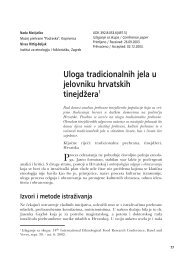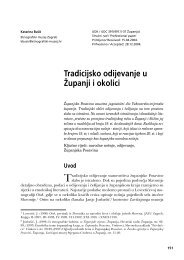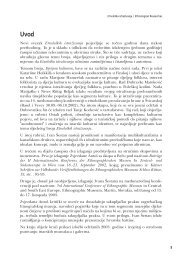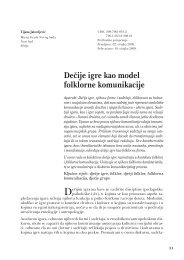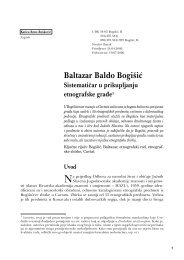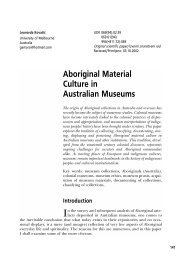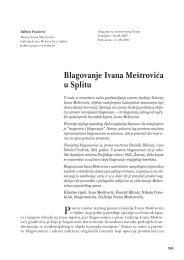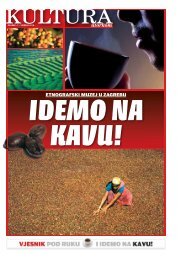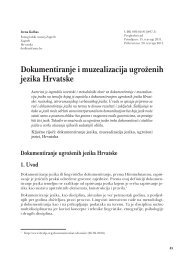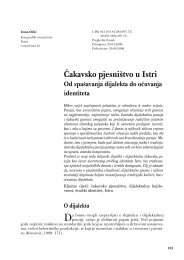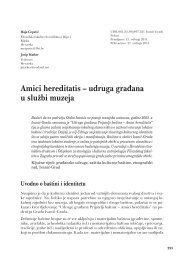Etnoloska istrazivanja / Ethnological researches - EMZ
Etnoloska istrazivanja / Ethnological researches - EMZ
Etnoloska istrazivanja / Ethnological researches - EMZ
You also want an ePaper? Increase the reach of your titles
YUMPU automatically turns print PDFs into web optimized ePapers that Google loves.
Etnološka istraživanja 15/<strong>Ethnological</strong> Researches 15are collectively remembered through the very act of performing them. 39 In such adaptationstradition is like a river, because one cannot step into the same water twice. Accordinglymaintained, the adapted public content is made part of the tradition whetherit is accounted for as “original” folklore or as a staged folklorism.Earlier mechanically understood as nameless upholders of tradition, today peopleand their communities can be distinguished by name and surname and as its creativeprotagonists and legally respected owners. These interesting social transformations,instigated by disciplinary discussions and adequate legal decrees, 40 increase the dynamicsof the culture of local communities with all their stratifications and complexitiesand ultimately strengthen traditions.The producers of cultural goods, in our time conjoining the roles of both producersand middle men for the market, with their creative and technological abilities are ableto satisfy the criteria of being a “creative class”. Such individuals with their work increasethe value of the product and therefore do become objects of interest for the investorson the markets of services (Florida 2003 and Hartley 2006 according to Švob-Đokić 2008: 63-65). 41 Goods created in this manner in today’s economy are subjectedto the whims of the consumer’s desires. The consumer’s choice of products containsa paradoxical dose of creativity which is evident in the case of fashion. 42 On this sitethe sharp boundaries between creativity, production and consumption become blurrywhile cultural consumption creates the enabling conditions for individualizations.Similarly to the reconstruction of historical ways of dressing, the possibilities of choosingin everyday ways of dressing also shares the characteristic of a creative act (Švob-Đukić 2008:44, Tarlo 1996:12 and 318). Individuality is expressed using the availablemeans, means which do not derive from the treasury of the cultural practices of selfsufficienteconomies nor share such a symbolically expressive inventory. 43 Such newconnotations of creativity earmarked for expansive markets 44 offer at the same time aspace for new creative practices, both individual as well as collective.39Tschmuck 2006: 183-193. for the costumed scenic performancs during the Middle Ages see Mugnaini2006:288.40Compare the impact of the 1991 NAGPRA law in the USA: museums were forced to present themselvesto the inheritors of local cultures as better places for presenting the restituable heritage while, on theother hand, scholars thereby become more highly motivated collaborators with the local community intheir separate interpretative initiatives.41The creator of new values is not one who bears risk. In the economy responsibility lies with the one whoseinvestments come to naught if his actions have no effect. As Schumpeter teaches, in economic innovationthe entrepeneur can only risk his reputation. Therefore the acting out of innovative practice is notan unambiguous procedure (McCraw 2007:74).42Compare today’s popular term fashion-buyer which refers to people whose purchase choice determinesthe collective taste in dressing; also see Hansen 2004:373. In West Africa the researcher is „“(Kriger2006:6)43J. Brody with his concluding observation about the new type of painting analyses the impact of creativemarket consumerism using the example of artefacts and artistic creations of the Southwest part of theUS: „“ (Brody 1979: 83).44„“ (Barrett 2002:16).222



